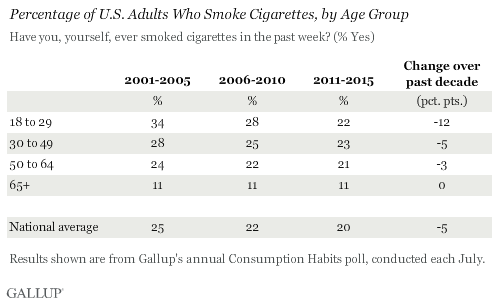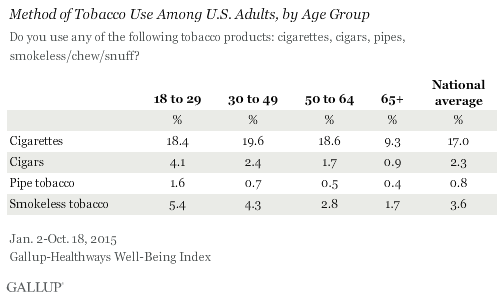Story Highlights
- Young adults now no more likely to smoke than those aged 30 to 64
- Young adults' use of smokeless tobacco, pipes and cigars above average
- Young adults most likely to use three or more forms of tobacco
WASHINGTON, D.C. -- The smoking rate for 18- to 29-year-olds in the U.S. has dropped 12 percentage points to 22% over the past decade, more than twice the drop seen for any other age group. In the early 2000s, young adults were significantly more likely to smoke than their older counterparts. But now smoking rates are similar among young adults and those aged 30 to 49 and 50 to 64.

Seniors remain much less likely to smoke than younger adults, and their smoking rates have not budged over the past decade.
These findings, collected as part of Gallup's annual Consumption Habits poll each July, align with those found in a recent Centers for Disease Control and Prevention study, which found that cigarette smoking has dropped most sharply among 18- to 24-year-olds.
At first glance, this dramatic drop in cigarette smoking among young adults appears to be encouraging news. It could mean that antismoking efforts are effective at preventing young adults from lighting up and possibly developing a lifelong addiction.
But new data from the Gallup-Healthways Well-Being Index, collected Jan. 2-Oct. 18, 2015, suggest that this decline might also be related to young adults switching to non-cigarette tobacco alternatives. Young adults' use of three other types of tobacco -- cigars, pipes and smokeless tobacco -- is well above the averages for all other age groups.
The use of non-cigarette forms of tobacco shows a consistent pattern by age, with young adults being the most likely of all age groups to use smokeless tobacco, to smoke pipes and to smoke cigars. The percentage who use any of those forms of tobacco is lower among each succeeding age group.

Since 2014, Gallup and Healthways have asked tobacco consumers to specify which forms of the product they use: cigarettes, cigars, pipe tobacco, smokeless tobacco, chew or snuff. Given the limited trend, Gallup and Healthways cannot determine whether young adults' use of non-cigarette tobacco alternatives has increased over time. But the data do show that young adults are more likely than those in all other age groups to use all types of non-cigarette alternatives.
Smokeless tobacco is the most common alternative to cigarettes among all age groups and is used by 5.4% of young adults, almost two points above the national average.
Cigar smoking is the next most popular tobacco form, used by 4.1% of young adults, versus 2.3% of Americans overall. Additionally, although relatively few people in any age group smoke pipes, the 1.6% found among young adults is twice the national average. It is possible that those interviewed may have considered water pipes, also known as hookahs, in their responses for "pipes." According to the CDC, between 2011 and 2014, high school students' use of hookahs showed a statistically significant increase, while their current use of more traditional products such as cigarettes and cigars decreased, resulting in no change in overall tobacco use.
An American Cancer Society report found that while cigars have previously been associated with older adults, most new cigar users are in fact young adults. Additionally, the CDC found that the greater appeal of cigar smoking among 18- to 29-year-olds may be attributed to the use of flavoring in many brands, and the fact that some cigars are less costly than cigarettes because state and local governments tax them differently. Furthermore, the popularity of specialty cigar shops may encourage social smoking and a connoisseur culture that is especially appealing to young adults.
Young Americans More Likely to Use Multiple Forms of Tobacco
Gallup combined the responses to the four tobacco items to see how many Americans are using multiple forms of tobacco. Overall, 20.4% of Americans use two or more forms, while 2.5% use three or more.

Twenty-three percent of 18- to 29-year-olds report using at least two forms of tobacco, similar to the use of multiple forms reported by middle-aged adults and about double the percentage reported by seniors. Far fewer young adults, 4.9%, use three or more types of tobacco, but this is significantly greater than any of the older age groups and nearly double the national average.
Bottom Line
Experimentation among young adults may be one possible explanation for their higher rate of non-cigarette tobacco use and their use of three or more forms of tobacco. According to a 2014 focus group study published in an Oxford University journal that studied the increase of e-cigarette use, the top reasons for young adults to experiment with tobacco alternatives are curiosity, appealing flavors and peer influences. Government regulations and increased taxation on cigarettes also may be leading young adults to embrace alternative methods of tobacco consumption.
Another possibility is that public smoking bans unwittingly may be contributing to the increased use of alternative tobacco products. In its most recent report on smokeless tobacco, the American Cancer Society attributes the increased use of alternative tobacco products among young adults to state and local smoking bans. The report states that tobacco companies are specifically marketing smokeless tobacco as an alternative to public tobacco consumption in places where smoking is not allowed. According to the report, smoking bans could be contributing to the "dual use" of tobacco among young adults.
With social stigma and government regulations on cigarette use continuing to increase, and a tendency for the young to experiment being an established characteristic of their age group, young adults have begun to seek alternatives to cigarettes. While previous Gallup research has shown that a majority of Americans -- young adults included -- are receptive to measures limiting cigarette smoking in public, the gradual decline in cigarette use may simply be the corollary of the rising use of smokeless tobacco and other alternative methods of tobacco consumption.
Gallup and Healthways will continue to monitor changes in tobacco consumption by subgroup and will report on e-cigarette use in the months ahead.
Survey Methods
Results for the cigarette-smoking trend are based on telephone interviews aggregated from Gallup polls conducted each July from 2011 through 2015, with a total random sample of 5,987 adults, aged 18 and older, living in all 50 U.S. states and the District of Columbia. For results based on the total sample of national adults, the margin of sampling error is ±1 percentage point at the 95% confidence level.
For results based on the sample of 792 18- to 29-year-olds, the margin of sampling error is ±4 percentage points at the 95% confidence level.
For results based on the sample of 1,448 30- to 49-year-olds, the margin of sampling error is ±3 percentage points at the 95% confidence level.
For results based on the sample of 1,829 50- to 64-year-olds, the margin of sampling error is ±3 percentage points at the 95% confidence level.
For results based on the sample of 1,918 adults aged 65 and older, the margin of sampling error is ±3 percentage points at the 95% confidence level.
Results for non-cigarette tobacco alternatives are based on telephone interviews conducted Jan. 2-Oct. 18, 2015, as part of the Gallup-Healthways Well-Being Index survey, with a random sample of 142,890 adults, aged 18 and older, living in all 50 U.S. states and the District of Columbia. For results based on the total sample of national adults, the margin of sampling error is ±0.32 percentage points at the 95% confidence level. All reported margins of sampling error include computed design effects for weighting.
For results based on 18- to 29-year-olds, Gallup surveyed 18,464 adults at a ±0.81 margin of sampling error at the 95% confidence level.
For results based on 30- to 49-year-olds, Gallup surveyed 33,566 adults at a ±0.61 margin of sampling error at the 95% confidence level.
For results based on 50- to 64-year-olds, Gallup surveyed 41,202 adults at a ±0.58 margin of sampling error at the 95% confidence level.
For results based on adults aged 65 and older, Gallup surveyed 47,267 adults at a ±0.55 margin of sampling error at the 95% confidence level.
Each sample of national adults includes a minimum quota of 60% cellphone respondents and 40% landline respondents, with additional minimum quotas by time zone within region. Landline and cellular telephone numbers are selected using random-digit-dial methods.
All reported margins of sampling error include computed design effects for weighting.
Learn more about how the Gallup Poll Social Series and the Gallup-Healthways Well-Being Index work.

